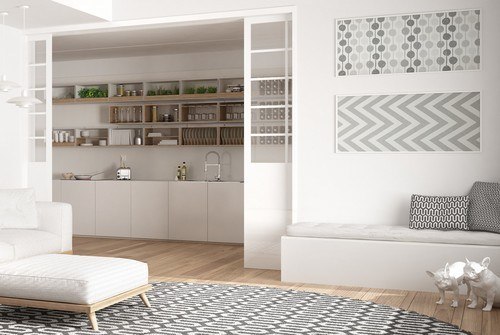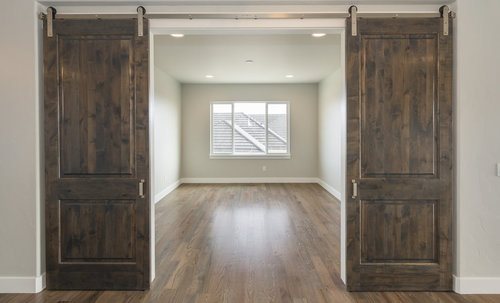Pocket Door vs Barn Door
Pocket Door
$500 - $2,900
(for 30-inch wood door installed)
VS
Barn Door
$500 - $1,200
(for 30-inch wood door installed)
Cost to install a pocket door or a barn door. varies greatly by region (and even by zip code).
To get free estimates from local contractors, please indicate yours.
Pocket Door

- Easily concealed when open
- Accessible
- Takes up little to no space
- Does not block or cover wall when open
- Many styles to choose from
- Fits with many home styles
- Difficult to install
- Difficult to maintain
- May come off track
- May not shut or seal properly
- Does not provide acoustic control
- Does not enhance resale value
(for 30-inch wood door installed)
Get free advice and estimates from door contractors in your city.
Barn Door

- Stylish, enhances appearance of room
- Takes up little to no space
- Easy to install
- Easy to maintain
- Less likely to develop serious issues
- Heavy and not as accessible
- Blocks or covers walls when open
- Not as versatile in style or design
- May come off track
- May not shut or seal properly
- Does not provide acoustic control
- Does not enhance resale value
(for 30-inch wood door installed)
Get free advice and estimates from door contractors in your city.
Sliding doors offer versatility in how you use your home. They open up two spaces into one, provide privacy when needed and do not take up the same space as a swinging door. Many styles of sliding doors are available, but two of the most frequently installed are pocket doors and barn-style doors. Both are great additions to many homes, but they have very different looks and functionality. We outline their differences below so that you can make the most informed decision about which will be right for your home.
Appearance
Pocket doors are an interesting addition to many homes because they slide into the wall, hiding the door when open. So, since the door is meant to be shut out of sight, the door itself may be very plain in style. However, they are also available in a wide range of styles, from traditional to contemporary, for the times that they will be seen. They also come in many materials as well, including wood, aluminum, and even mirrored finishes.
Barn doors have a more distinctive style. Made of wood, these doors generally have a more rustic finish and appearance. They fit in well with a variety of home styles, including country, rustic modern, cottage, and farmhouse. However, they do not tend to work as well in contemporary or traditional spaces.
Best Use
Both pocket doors and barn doors are meant to be space-saving. They do not swing out into the room, so they work well for bathrooms, closets, and areas that need more accessibility.
However, pocket doors slide into the wall and are concealed when open. Barn doors slide on a track on the outside of a wall and cover it when open. This means that pocket doors slide between rooms and hallways, making them slightly more versatile.
Barn doors may also block outlets and wall switches when open, so they need to have a blank wall to slide over. So, no artwork or shelving can be installed there. Because pocket doors go inside the wall, there is no need to leave the exterior wall blank.
Installation
Because pocket doors are installed on a track that is both in the doorway and inside the adjacent wall, they are more difficult and time-consuming to install. In some cases, the wall must be opened up to install the track. And in other cases, the wall may not be thick enough to conceal the track, in which case, the wall must be rebuilt. In addition, a load-bearing wall 1 may not have enough space inside to conceal the door, which would make the installation of a pocket door impossible without redistributing the load.
Barn doors, on the other hand, install across the doorway and along the outside of the adjacent wall. This makes them much easier to install because the track can be seen at all times, without needing to open the wall or refinish it after installing the track. The track can be installed on any wall, no matter how thin or if it is load-bearing.
Since the track is visible at all times, however, that means it is often larger and more decorative than the pocket-door track. This makes handling it slightly more difficult as well as more expensive to purchase.
Costs
The biggest difference in cost between a pocket door and a barn door generally comes from the installation. Pocket doors can be very difficult to install in an existing wall, which can drive up the final cost considerably. In fact, pocket doors are most commonly installed in new construction for this reason.
Both doors have a starting cost of around $400 for a 30-inch solid wood door. But while the cost of installation for a barn door is around $100 to $300 regardless of new construction or an existing wall, a pocket door’s installation costs range from $100 to $500 for new construction and $1,000 to $2,500 for installation in an existing wall. That makes the total cost of a barn door between $500 and $1,200, while costs range for a pocket door from $500 to $2,900 installed.
Sealing
If you need to shut the door tightly for privacy, light blocking, or sound diminishing purposes, a tight seal may be necessary. Some pocket doors and barn doors may slide easily to fit across the doorway but are not designed to shut tightly. Some may have a locking or catching mechanism that can hold the door shut, but if the track or door becomes even slightly out of alignment, the door may gap slightly at the top or bottom, preventing it from making a tight seal. This can be true of either style of door.
Maintenance
Both styles require some maintenance. Because they each slide along a track, it must be kept in good condition, free of any debris that could cause the door or rollers to catch. They may also require periodic oiling or rehanging if the track sags.
Because a barn door is completely visible and easily reached, this maintenance is often easier to carry out than on a pocket door. For the pocket door, at least half the track is concealed in the wall, which can make maintenance more difficult.
Durability
Both doors involve a track, which can sometimes cause problems with durability. It comes down mostly to the quality of the track and the materials that go into making it.
Both doors may come off their tracks, become difficult to roll, may squeal or squeak if not lubricated, and may gap or hang, making them difficult to seal and lock. However, barn doors often have a larger track because the door is visible. This means that the track may experience fewer issues over time than the smaller pocket door track.
Barn doors are more accessible to fix issues when they occur, so major problems are less common than with pocket doors, where a small issue may get out of hand because it cannot be easily reached.
Noise
Pocket and barn doors are not designed for acoustic insulation in general. It is possible to add some acoustic paneling to the doors themselves to reduce sound, but this can make the doors heavier and more inclined to come off their tracks.
When the doors open and close properly, they should operate smoothly with little to no sound. However, both doors may develop squeaks or squeals if they are not properly oiled on a regular basis. However, barn doors are easier to lubricate than pocket doors, which may make them easier to keep quiet.
Accessibility
Both doors are meant to slide, which can make them easier to use for a person requiring mobility aids. One does not have to move out of the door’s way when opening it. However, of the two, pocket doors are considered more accessible, because they are generally lighter and, therefore, easier to slide.
Resale Value
Neither door adds much to the value of the home. Barn doors are a very specific style that may not appeal to everyone, while pocket doors can sometimes be difficult to maintain, which may also limit their appeal.
Remodeling Terms Cheat Sheet
Definitions in laymen's terms, cost considerations, pictures and things you need to know.See full cheat sheet.
How much does it cost to install a pocket door or a barn door. in my city?
Cost to install a pocket door or a barn door. varies greatly by region (and even by zip code).
To get free estimates from local contractors, please indicate yours.